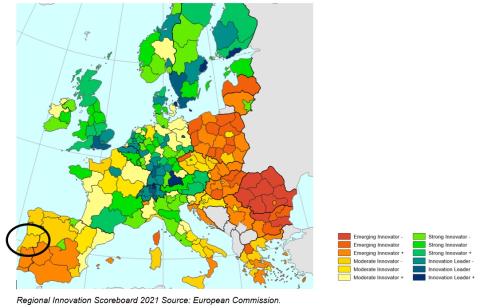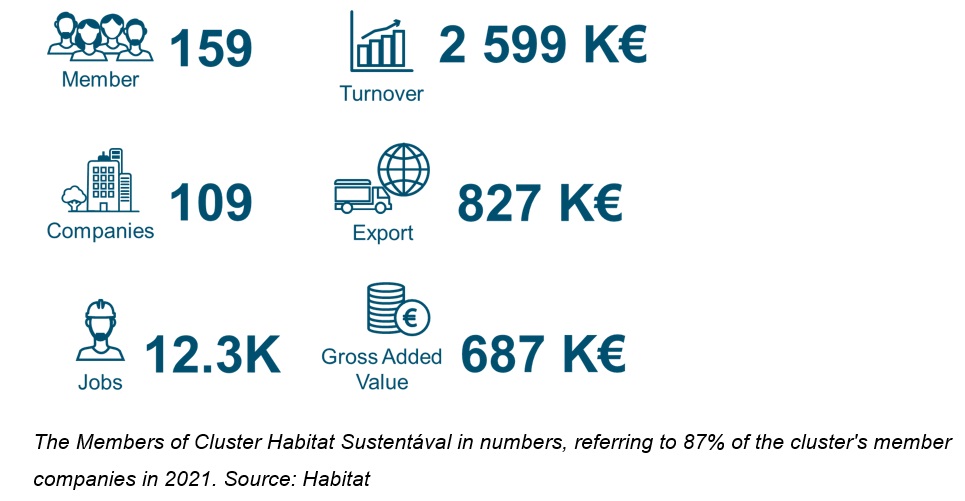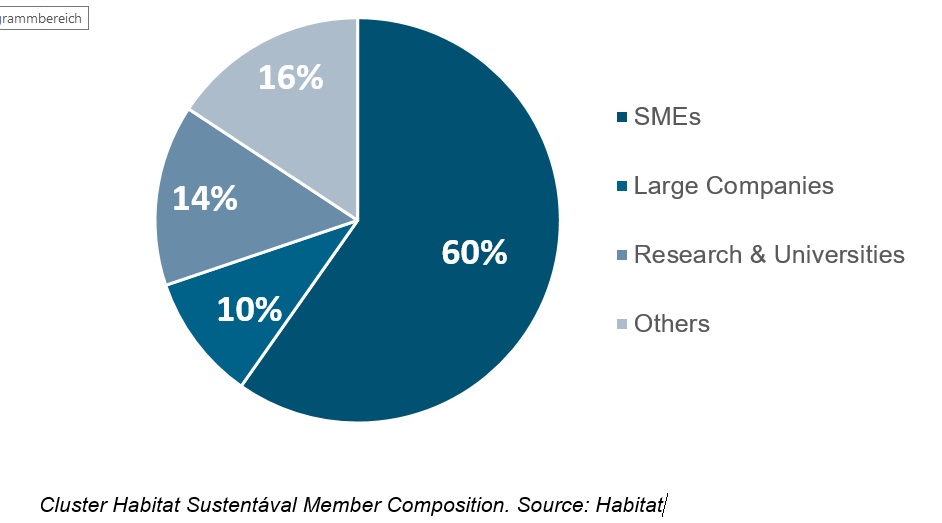Visionary work with limited resources
Summary: The Habitat Cluster Portugal is a dynamic ecosystem, fostering the success of its members within the ever-evolving realms of construction and design. Established in 2009, the cluster highlights how long-term success hinges on the comprehensive integration of the entire Habitat value chain, coupled with a steadfast commitment to sustainability. From its inception, the cross-sectoral cluster has leveraged a "first-mover advantage" in the area of sustainability, boldly embracing a visionary strategy long before these themes became ubiquitous in contemporary discourse. This foresight has afforded them a substantial lead of nearly a decade in green deal and sustainability initiatives over competitorscurrently grappling with these concerns. Consequently, the Habitat Cluster Portugal is now a highly sought-after partner on both national and international levels.
The Centro Region

Portugal’s Região Centro (Central Region) is, true to its name, the central hub of Portugal, encompassing a substantial 31% of the nation's mainland and is home to 2.2 million inhabitants, equivalent to 22% of the country's total population. The city of Coimbra is the largest with 143,000 residents, closely trailed by Aveiro. While the coastal zones exude a palpable dynamism, the rural landscapes are marked by a sparse presence of institutional and economic activities.
In terms of demographics, the region experiences a relatively low overall population density, underscored by a territorial asymmetry between the more urbanised and coastal expanses and the less inhabited rural and interior domains. Notably, the Região Centro is navigating a significant social transformation, grappling with the weight of the oldest demography in Portugal and one of the oldest in Europe. This demographic landscape presents a challenge, characterised by a population in decline and advancing in age, accompanied by a notable dependency ratio, particularly in the rural hinterlands.

The Centro region is one of seven Portuguese regions, which do not have any corresponding administrative bodies. Instead, Portugal is strongly centrally steered, not least due to its size, even though there have been recent efforts towards decentralisation and the associated transfer of competencies from national to regional level.
INDUSTRIAL ECOSYSTEMS and STRATEGIC CHALLENGES
Portugal employs a multi-level strategy for smart specialisation (S3), comprising a national strategy and seven regional strategies. The Região Centro, in alignment with this approach, has developed its distinctive S3 strategy. The focal points of Centro's S3 priorities are encapsulated within four regional innovation hubs, each mirroring a key strategic challenge:
- Valorisation of natural endogenous resources
- Sustainable industrial solutions
- Technologies for quality of life / active and healthy ageing
- Territorial innovation

These innovation hubs are an attempt to leave the more traditional industrial ecosystems behind and no longer focus so strongly on individual sectors. Instead, the emphasis lies on fostering a more pronounced cross-sectoral focus, with these platforms serving as transformative agendas for the entire central economy. Simultaneously, these centers intersect with the region's most important regional clusters.
The subordinate priority domains represent strong and potentially strong industrial ecosystems in the region:
- Natural Resources & Bioeconomy
- Energy & Climate
- Production Technologies, Tooling & Materials
- Health & Well-being
- Digital Technologies & Space
- Culture, Creativity & Tourism
CLUSTER POLICY and CLUSTERS
Cluster policy in Portugal is relatively new and currently focuses solely on a national level. In 2008, Portugal introduced the "Framework for the Collective Efficiency Strategy" (EEC) to boost the competitiveness and internationalisation of its economy. This process identified 19 national cluster initiatives, officially acknowledged by the government. Subsequently, in 2010, 16 of these clusters formed an informal partnership called PORTUGALclusters to facilitate various activities and regular meetings.
In 2015, a new regulation was established to officially recognise competitiveness clusters. Presently, the Centro region hosts ten cluster initiatives, three of which hold a valid ECEI Gold Label:
- Cluster Habitat Sustentável
- TICE.PT – Association for the Information, Communication and Electronic Technologies Centre
- POOL-NET – Portuguese Tooling & Plastics Network
Furthermore, the region houses a branch of the national InovCluster – Agro-Industrial Cluster Association, which was also honoured with the ECEI Gold Label. A common thread among these cluster initiatives is their cross-sectoral orientation and partial alignment with the innovation hubs of the regional S3.
Further reading:
Connection between the clusters in the Centro region and the innovation hubs of the regional S3 strategy: https://s3platform.jrc.ec.europa.eu/en/w/s3-creates-regional-innovation-hubs
Case Study Green Transition Centro Portugal ; Case studies towards Green Transition in EU regions, 2022: https://publications.jrc.ec.europa.eu/repository/handle/JRC130517
Sustainable Habitat Cluster

The Cluster Habitat Sustentável predates the EU Green Deal or more recent initiatives on sustainable construction or green industrial transition by far: The cluster was founded in the wake of the 2008 financial crisis, that significantly impacted Portugal, especially its construction industry. The cluster initiative emerged in 2009 to support the struggling sector. Yet, it did not confine itself to this role. From the outset, the cluster management emphasised a comprehensive approach, considering the entire habitat value chain – from raw materials and building material processing to construction, refurbishment, and activities involving suppliers of goods and equipment for the built environment. Sustainability has been the driving force behind the Habitat cluster's innovation and transformation efforts, aspiring to contribute to a “more sustainable living environment”. Recognising this commitment, the cluster was awarded the Gold Label of the European Cluster Excellence Initiative in 2015, a commendation honouring the top cluster management organisations in Europe, successfully renewed in 2018. This distinction positions the Habitat Cluster as one of only two gold-labelled clusters dedicated to the construction industry.
The entities within the Habitat Cluster aim to foster synergies for developing new products, technologies, and building systems, pioneering innovative spatial design and surrounding areas. This approach reflects a commitment to innovation through sustainable built environments, ultimately geared towards enhancing competitiveness.
MAIN FEATURES
The Habitat cluster presently comprises 159 members, with 70% constituent companies, the majority of which are Small and Medium-sized Enterprises (SMEs). Predominantly, these companies function as material manufacturers. However, adhering to the value chain approach, the cluster also incorporates traditional construction and renovation companies, along with suppliers of goods and equipment for buildings.


Furthermore, the membership encompasses 23 scientific entities, 8 municipalities, 11 associations and other organisations, including NGOs and as well as public entities like the urban planning institute.
In relation to its extensive membership, the cluster management team is relatively compact. Comprising five individuals, all part-time contributors to the cluster initiative, the team maintains efficiency through a close affiliation with the university in Aveiro. This connection extends both to personnel and dedicated space, facilitating collaborative endeavors.
Collaboration within the cluster unfolds through four distinct working groups, each dedicated to various facets of a sustainable living space:
- Sustainable industrial solution: Looks out e.g. for new construction and rehabilitation technologies and systems
- Well-being and health in habitat: Deals with the question of what an ageing society needs for its living space
- Circularity and material efficiency: Searches for recycling solutions and new components for classic materials
- Sustainable cities and territories: Explores the question of how cities can grow suatinable in the future
These groups convene regularly, meeting four times a year at fixed intervals.
SERVICE PORTFOLIO
The Habitat services portfolio encompasses a diverse array of activities, ranging from the more traditional to the less common among cluster initiatives.
More traditional:
- Technical Information: The cluster provides publications and scientific articles covering materials and product sustainability, building and construction projects, resource efficiency, as well as technologies and systems.
- Solution Offers: Habitat Sustentável showcases its members' products and offerings on its platform, actively promoting them.
- Trainings & Events: In addition to a biennial congress, the cluster conducts seminars on specific topics, as well as courses and workshops.
Others are less common:
- Support Office for Sustainable Enterprises and Projects (GAPES): The office provides support in liaising with authorities and public bodies. In doing so, GAPES helps to establish contacts with municipalities as well as (inter)national partners and offers advice on promoting and evaluating innovation projects and strengthening business opportunities.
- Environmental Product Declaration: Through the DAP Habitat System, developed by the Cluster initiative, organisations have the capability to submit applications for Environmental Product Declarations (EPDs) for their products and services. The EPD serves as a precise and scientifically verified communication tool, conveying environmental information about products and services. This not only enhances transparency but also creates avenues for new market opportunities.
- Sustainability Seal for organisations: This quality label, similar to the ECEI cluster labels, is awarded on the basis of objective and strict criteria in 3 categories (Gold, Silver, Bronze) and allows candidates to see their sustainability efforts recognised as an institution (company, municipality and others).
IMPACT
Although the cluster was set up with the construction industry in mind, it has seen itself as a "Green Transition Cluster" from the outset. The thematic focus is on decarbonisation and the circular economy. To this end, the cluster is working on resource-efficient solutions for buildings. These are not limited to energy-efficient solutions, but solutions for the realisation of CO2-neutral and water-efficient buildings. The cluster works on three levels to create a sustainable living space:
- Decarbonisation of the materials used
- Urban and land development
- Level of each building
The cluster systematically explores how the built environment can positively impact the non-built habitat, recognising the construction industry's pivotal role in achieving decarbonisation and circularity goals.
Active engagement with members and strategic influence on regional and national policies form integral parts of the cluster's approach. With ‘habitat’ being integral to the national Smart Specialisation Strategy (S3), the cluster, even in its early stages, played a role in defining the regional S3 strategy for the Centro Region from 2012. Currently, Habitat Sustentável oversees the second Innovation Hub, “Development of Sustainable Industrial Solutions”, positioning it as a key player in shaping the implementation of the RIS3 strategy and the overall economy in the Centro Region.The cluster's influence extends to national initiatives, evident in its involvement in Portugal’s national action plan for the circular economy.
A notable success story involves the development of the Environmental Product Declaration (EPD) national registration system (DAPHabitat), which aligns with the cluster’s strategy to leverage sustainability as a driving force for the industry. The EPD serves as a comprehensive document containing vital information about the environmental impact, positioning it as a crucial tool for promoting eco-design. Over 40 EPDs have been created since the launch in 2016.
In line with these efforts, the cluster actively seeks to influence regional policy in support of green public procurement. Recognising public procurement as a driver for innovation, the cluster engages with the Competence Centre for Innovative Public Procurement. Specific measures within this initiative aim to collaborate with the government on sustainable public procurement and associated procurement of innovations. The above-mentioned national registration system DAPHabitat, developed by the Habitat Cluster, serves as a potential cornerstone for establishing criteria for such procurement.
Last but not least, the cluster combines environmental sustainability with social issues such as demographic change. The Excellent Living Environments (EXCELIVING) project aims to address the challenges facing the habitat value chain today and help promote a favourable ecosystem to give the European habitat value chain a competitive edge in promoting healthy, age-friendly and sustainable spaces. The Portuguese cluster is working with partners from Romania, Denmark and Spain, among others, on how an ageing society can remain living at home in the long term, for example by installing sensors in furniture and creating an accessible and age-friendly environment.
All these examples illustrate that the Habitat Cluster is an interesting partner for many topics relevant to the future, both for policy and for Portuguese and international stakeholders.
LESSONS LEARNED AND TRANSFERABILITY

The Habitat Cluster is a compelling example of successful cluster activities despite resource constraints. This success is, in no small part, due to its close ties with the University of Aveiro and the cluster's strong international and cross-sectoral orientation.
The cluster is utilising its “First Mover Advantage” in sustainability, demonstrating courage in adopting a visionary strategy for the construction industry as an ecosystem, even before ecological considerations and a holistic view of the value chain became as prevalent as they are today. Currently, they have a head start of almost ten years on Green Deal and sustainability topics compared to their competitors, turning them into a sought-after partner on both national and international levels.
A distinctive feature in the collaboration between the region and the Habitat Cluster (as well as other recognised clusters in the region) is the explicitly outlined Innovation Hubs within the strategy. These Innovation Hubs serve as transformative agendas for the region and, to a large extent, align with the clusters residing in the region. They function as drivers of transformative agendas, with the cluster manager of the Habitat Cluster, Victor Ferreira, concurrently serving as the coordinator of the second Innovation Hub, “Development of Sustainable Industrial Solutions.”
This synergy ensures the coordinated interplay of regional and cluster strategies, guaranteeing the effectiveness of their efforts, with clear responsibilities assigned to each agenda. Simultaneously, the intersection of regional clusters and Innovation Hubs ensures that regional strengths are precisely defined and tightly integrated into the S3, avoiding the pitfalls of overly broad focus areas – an acknowledged success factor for implementing the S3 strategy.
Cross-clustering activities also play a pivotal role in strategy implementation, as they facilitate the intersection of Innovation Hubs with various Priority Hubs. This structure creates a compelling incentive for active collaboration among all stakeholders, extending well beyond superficial networking, fostering a robust culture of cooperation.
RECOMMENDATIONS
The case of Cluster Habitat Sustentável illustrates how cluster initiatives can play a vital role in regional transformation when actively involved in strategy development and clearly defined as agents of change. This is exemplified in the strategic field of 'Habitat,' where effective interaction between national and regional strategies and the activities of local actors is crucial. The success of Cluster Habitat Sustentável also highlights the growing trend of developing solutions and services beyond a specific sector and instead focusing on the entire ecosystem, which is a significant step towards driving change. Additionally, the case underscores the importance of international engagement and partnerships within European programmes and initiatives, as they enable access to new value chains, technologies, and skills.